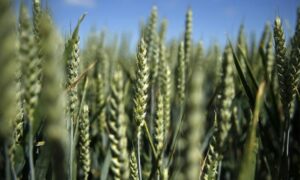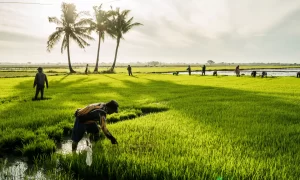Wheat breeding strategies for increased climate resilience

As climate change intensifies, CIMMYT scientists conducted simulations using 3,652 wheat breeding lines from global nurseries to assess future climate scenarios. Their findings, published in Nature Climate Change, reveal that less than one-third of wheat varieties adapted well to recent warming trends. The study highlights the need for breeding programs to prioritize stability and climate resilience over yield alone. Researchers emphasize increasing genetic diversity and targeting traits for heat tolerance. They also suggest leveraging wild wheat relatives and new breeding techniques to future-proof wheat against expected climate challenges.
With the challenges of climate change already affecting plant breeding, especially warmer days and warmer nights, the time to future proof the world’s food supply is now. In order to make the best-informed changes, scientists at CIMMYT ran simulations mimicking five scenarios that might play out over the next 70+ years.
The researchers used 3,652 breeding line records from six global nurseries administered by the International Wheat Improvement Network, which is coordinated by CIMMYT, and involves hundreds of partners and testing sites worldwide. Researchers ran the data through five different climate change scenarios, ranging from stable to severe.
Along with colleagues from Henan Agricultural University, Zhengzhou, China, ICARDA, and the Chinese Academy of Agricultural Sciences, CIMMYT scientists published their research in Nature Climate Change.
The results showed that less than one-third of wheat varieties adapted well to the warming the planet has already seen in the last 10 years. As temperatures increased in the simulation, researchers found a clear connection between rising temperatures and lower stability for a variety. As the global wheat-growing area becomes warmer and experiences more frequent heatwaves, breeding programs have to look beyond just yield optimization.
“Stability is key for breeding programs and farmers,” said co-lead author Matthew Reynolds, CIMMYT distinguished scientist and head of wheat physiology. “Knowing that a specific variety works well in a specific environment and produces an expected amount of yield allows farmers better plan their crop futures.”
“We performed the analysis from different perspectives, so that climate effects and appropriate adjustment suggestions for current breeding models can be considered from climate change, gene selection and/or gene–environment interaction perspectives,” said co-lead author Wei Xiong, CIMMYT Senior Scientist and Agricultural System Modeler.
The paradox of breeding elite lines
Local and regional breeding programs, as well as targeted breeding by CIMMYT, contribute to gene pools that overlap for many key agronomic traits, which limit genetic diversity.
“It is an unintended consequence,” said Reynolds. “As conventional breeding focuses on crossing the best and elite material, such focus can actually reduce genetic diversity.”
This ‘paradox’ shows the need to increase genetic variability and environmental diversification in breeding programs that are developing higher-yielding climate-resilient cultivars. Breeding programs also need to target traits associated with improved adaptation to increased temperatures and tolerance to heatwaves, which requires multidisciplinary integration.
Looking to the past for answers
Over the past 10,000 years, the climate has been unusually stable, meaning modern, domesticated bread wheat has not been exposed to wide swings in temperature that are forecast for the next 100 years. Wild wheat relatives, like Triticeae, have had millions of years of experience in weathering changing climates.
CIMMYT has a pre-breeding program that examines wild wheat races and more exotic sources for climate resilience traits. When such traits are identified genetically, new breeding techniques such as gene editing can be employed and breeding models refined.
To activate these new techniques, several barriers need to be overcome, including more sharing of germplasm between countries and breeding teams, the use of faster breeding cycles where appropriate and improved understanding of genes that improve heat tolerance without a yield penalty.
With reduced climate resilience and slow cultivar development, the need to increase genetic variability for climate adaptation is urgent, particularly in developing countries, where warming rate is unprecedented, and breeding cycles tend to be longer than in developed countries.
“Faced with more climate variability, breeders need to revisit their breeding strategies to integrate genetic diversity that confers climate resilience without penalties to productivity,” said Reynolds.
Source Link : https://www.cimmyt.org/news/wheat-breeding-strategies-for-increased-climate-resilience/
















